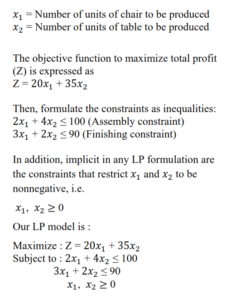Formulation of Linear Programming Problem(LPP)
The construction of objective function as well as the constraints is known as formulation of Linear Programming Problem(LPP) .
The following are the basic steps in formulation of LPP.
- Identify the variables to be determined and then express these by some algebraic symbols.
- Locate the various constraints/restrictions present in the problem ans express these linear equations/inequalities which are some linear functions of the variables identified in step (i).
- Determine the objective of the problem and express it as linear function of the decision variable involved in the phenomenon.
Example 1
The Omni Furniture Manufacturing Company produces two products: Table and Chair. Both products require time in two processing departments. Assembly Department and Finishing Department. Data on the two products are as follows:
| Processing | Desk | Table | Available Hours |
| Assembly | 2 | 4 | 100 |
| Finishing | 3 | 2 | 90 |
| Profit per unit | $20 | $35 |
The company wants to find the most profitable mix of these two products. Define the decision variables as follows :

Example 2
A resourceful home decorator manufactures two types of lamps A and B. Both the lamps go through two technicians first a cutter and then a finisher. Lamp A requires 2 hours of cutter time and one hour of finisher’s time. Lamp B requires one hour of cutter time and two hours of finisher’s time. The cutter has 104 hours and finisher 76 hours available time. Profit on one lamp of A is Rs. 6.00 and one lamp of B is Rs. 11.00. Assuming that the decorator can sell all that he produces, how many of each type of lamps should he manufacture to obtain the best return?
Solution
It is typical LPP. Here the profit will depend or the output or Lamps A and B. SO we are to find the optimum combination of the outputs of A and B .Let the manufacturer produce X units of A and Y units of B. Then profit from X units of A will be 6X and profit from Y units of B will be 11Y and the total profit from X units of A and Y units of B will be
Z = 6X + 11Y
Now we want to find that combination of X, Y for which Z is maximum. Hence our objective function is
Maximize Z = 6X + 11Y
Again X units of A will require 2X hours of cutter time and Y hours of finisher time. Similarly Y units of B will require Y hours of cutter time and 2Y hours of finisher time.
Thus cutter time required for producing X units of A and Y units of
B = 2X + Y
And the corresponding finisher time will be = X + 2 Y
But the total time available for cutter and finisher is respectively 104 hours and 76 hours. Hence we get the constraints as
2X + Y ≤ 104 (Cutter time)
X + 2Y ≤ 76 ( Finisher Time )
And X, Y ≥ 0 is the non- negativity restriction. Thus the mathematical model for the formulated LPP can be written as
Max. Z = 6X + 11Y (Objective Function)
2X + Y ≤ 104
X + 2Y ≤ 76 (Constraints)
X, Y ≥ 0 (non-negativity restriction)

